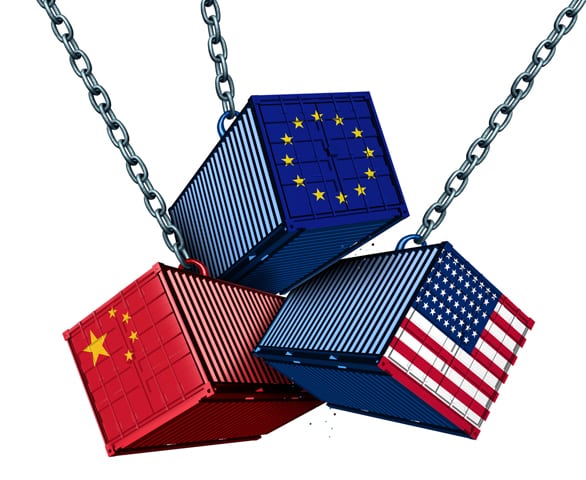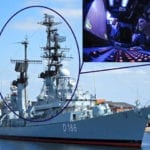The Connector Industry Braces for the Impact of Tariffs
The developing trade war could bring significant consequences to the electronics industry.
The Connector Industry Braces for the Impact of Tariffs
 The US government has weighed imposing tariffs on imports for over a year, and in recent weeks these discussions have escalated into action as tariffs have come into effect on trade relationships around the globe. President Donald Trump is hopeful the tariffs will encourage negotiations that result in new trade deals that are more favorable to the US and eliminate the unfair tariffs and trade barriers imposed by the European Union (EU) and China. Should the tariff strategy not result in negotiations that produce fair trade for the US, there will be a significant impact on the world’s manufacturing footprint. Fewer electronic products will be shipped from the EU and China to the US. In response, more electronic products will be manufactured in the US to service US demand, but at a higher cost to consumers. The full results of these actions are yet to be seen, and a full-on trade war is not desired by or beneficial to anyone. Hopefully, negotiations will begin and the trade tensions between the US, the EU, and China will calm. Bishop & Associates will be closely watching as the situation evolves.
The US government has weighed imposing tariffs on imports for over a year, and in recent weeks these discussions have escalated into action as tariffs have come into effect on trade relationships around the globe. President Donald Trump is hopeful the tariffs will encourage negotiations that result in new trade deals that are more favorable to the US and eliminate the unfair tariffs and trade barriers imposed by the European Union (EU) and China. Should the tariff strategy not result in negotiations that produce fair trade for the US, there will be a significant impact on the world’s manufacturing footprint. Fewer electronic products will be shipped from the EU and China to the US. In response, more electronic products will be manufactured in the US to service US demand, but at a higher cost to consumers. The full results of these actions are yet to be seen, and a full-on trade war is not desired by or beneficial to anyone. Hopefully, negotiations will begin and the trade tensions between the US, the EU, and China will calm. Bishop & Associates will be closely watching as the situation evolves.
In the short term, it is clear that tariffs will impact the connector industry. Companies that import electronic connectors, harnesses, and assemblies from China now have a 25% tariff, and we believe it is going to be difficult to pass these additional costs on to the buyer. Therefore, importers from China will have to obtain these products from US manufacturers or countries that are not subject to these tariffs. As such, these products may no longer come from China.
Bishop & Associates is paying special attention to trade actions that impact electronics components. These trade actions have a direct impact on the connector industry, dating back to the beginning of the year:
- January 22: The US imposes 30% tariffs on foreign-made solar panels and washing machines.
- March 23: The US imposes 25% tariffs on steel imports and 10% tariffs on aluminum imports, with exemptions to Canada, Mexico, and the European Union.
- April 2: China responds with tariffs on $3 billion worth of US imports.
- May 22: Japan tells the WTO that it may respond to US steel tariffs with counter measures.
- May 29: The US announces plans to hit China with 25–40% tariffs on $50 billion worth of goods, with a special emphasis on technology products.
- June 1: The US reverses its original exemptions and begins charging tariffs on steel and aluminum imports from Canada, Mexico, and the European Union after all; those countries announce counter tariffs.
- June 6: Mexico imposes tariffs on $3 billion worth of US goods, including steel.
- June 15: The US announces another round of tariffs on $50 billion of Chinese exports starting July 6, targeting the Chinese aerospace, robotics, manufacturing, and auto industries; China responds with tariffs on US goods, affecting autos and planes, as well as farm goods.
- June 18: Trump announced plans for additional tariffs on $200 billion of Chinese goods, affecting 800 categories of products, with an emphasis on electronics.
- June 21: India imposes tariffs on US products, including metals.
- June 22: the EU imposes tariffs on US products, including motorcycles.
- July 1: Canada imposes tariffs on $12.5 billion worth of US imports, including 40 steel products.
- July 6: The US activates the first $34 billion of a planned $50 billion in tariffs on Chinese imports; China responds with tariffs on $34 billion worth of US imports.
- July 6: Russia responds to steel tariffs with tariffs of 25–40% on $87 million of US-produced road construction equipment, oil and gas equipment, metal processing instruments, drilling equipment, and optical fiber.
- July 18: Alabama Senator Doug Jones and Tennessee Senator Lamar Alexander co-sponsor the Automotive Jobs Act of 2018, a bipartisan bill that would delay the auto tariffs. Tariffs of 25% on imported autos and auto parts are pending the outcome of a Section 232 investigation into whether auto imports pose a national security threat. Commerce Secretary Wilbur Ross predicts the report will be available in August.
- July 20: Trump announced that he’s ready to impose tariffs on every single product the US imports from China, an amount that would total $500 billion.
- July 24–25: The US Trade Representatives office held public hearings to discuss proposed tariffs on $16 billion worth of goods from China.
- July 25: President Trump and European Commission President Jean-Claude Juncker meet, agree to work towards “zero” tariffs.
- July 27: Companies including BMW, Coca-Cola, and Caterpillar have announced that they will raise prices to offset increased materials costs due to tariffs.
- July 31: Japan, Canada, the EU, and South Korea meet in Geneva to discuss strategies for dealing with proposed tariffs of 25% on imported autos and auto parts.
The Harmonized Tariff Schedule issued by the United States specifically targets connectors. Sections 8535 and 8536 describe tariffs of 35% on “electrical apparatus for switching or protecting electrical circuits, or for making connections to or in electrical circuits.” The schedule includes terminals, electrical splices and electrical couplings, switches, relays, fuses, surge suppressors, plugs, sockets, lamp-holders and other connectors, connectors for optical fibers, optical fiber bundles or cables, coaxial connectors, cylindrical multi-contact connectors, rack and panel connectors, printed circuit connectors, ribbon or flat cable connectors, and other components used in electronics. In addition to connectors, related technologies, including PCBs, LEDs, capacitors, processors, resistors, and printed circuit assemblies, are also affected.
Technology is now firmly integrated into every sector of the economy. This means that tariffs that target electronic components have an echo effect that will reach across industries. Businesses facing higher costs due to tariffs must decide how to proceed: They can absorb the cost and accept lower profits, pass the costs onto consumers, or cut costs through increased manufacturing in the US for products that will be consumed in the US. US exporters, assuming the EU and China counters with tariffs, may have to move operations out of the US, such as Harley-Davidson has planned.
So far, trade talks between the US and China have failed to produce significant progress. Instead, China has begun to reach out to the EU to create new trade relationships. China is the EU’s biggest source of imports and its second-biggest export market. Chinese Prime Minister Li Keqiang says he will open up China’s economy to the wider world. In early July, he met with eastern and central European leaders and German Chancellor Angela Merkel, and hosted an EU-China summit in Beijing.
In the US, markets for connectors, including automotive, heavy machinery, and transportation, are already feeling the impact of tariffs. Daimler AG and Volvo have plants in Alabama and South Carolina that build vehicles for sale overseas. These foreign-owned companies are now facing tariffs on US-built vehicles and have scaled down earning projections in anticipation. Caterpillar announced that it has hit the “high-water mark” and doesn’t expect to see strong sales in the coming quarters. Tesla has raised the price of its cars sold in China by 20%. Cars made in the US feature significant amounts of imported materials and components. Toyota estimates that tariffs will add $1,800 to the cost of each new car made in the US. In addition to Harley-Davidson, Polaris has announced plans to move manufacturing overseas and BMW is increasing manufacturing capacity in China to lower its reliance on imports from a US factory.
The impact of tariffs is just beginning to sink in for many companies. Due to lead times and the implementation schedule of the tariffs, many businesses will face the impact of tariffs only in the second half of the year. However, connector companies are now operating in a changed business environment.
Bishop & Associates will continue to report on this issue as it develops. To gain a better idea of how technology-based companies are affected by tariffs, we’d like to hear from our readers. Drop a line to Ron Bishop to share your observations.
Bishop Comments:
- The US strategy is clearly to implement tariffs as an incentive for the EU and China to negotiate fair trade agreements and eliminate unfair trade barriers. Failing to obtain fair trade agreements, the US is opting instead for reciprocal trade, i.e., the US imposes reciprocal tariffs and trade barriers. The goal is to eliminate the large unfavorable trade balance, reported to be $151 billion with the EU and $500 billion with China on an annual basis. It is a certainty that the EU and China will not give up their favorable trade balances because the US asks them to do so.
- A “tariff war” with China is unwanted by all. A trade war is not good for business. Should the trade war gain momentum, there be a significant negative impact on the connector and overall electronics industry. We also believe a trade war would cause a major shift in the world’s manufacturing footprint.
- A “hard 25%” inserted into most companies’ income statements will start a massive repricing for customers/buyers, which will in turn send the buyers/users looking for new sources/suppliers. Existing supply contracts will punish the buyer or the seller. A massive renegotiation and perhaps resourcing will begin.
- No one will invest in anything of significance until the dust settles. Companies will face a near insurmountable tool bill if Chinese work has to be repatriated. Tools and machines sent to China in the distant past will have disputed ownership. Supply issues will be colossal. Chinese assets could become worthless. The component industry is not the venue where unfair trade with China is practiced. The component industry has incorporated China into its fabric and has become reliant on China. The component industry will probably suffer unintended consequences of the fair/free trade war.
- Companies will scramble to try to retain the cost advantage of their in-place logistics by modifying the logistics to avoid full or partial impact. Almost every Taiwanese, Vietnamese, or Korean supplier has Chinese content today in the raw material or sub-component level. No one knows if tariffs on these countries won’t follow a successful outcome in China. There is little to gain and a huge bill to pay while this gets sorted out.
- While the United States needs to do this, it will be best for our industry if it gets done quickly.
- The US stock market appears to be calm and pricing stocks in the assumption that the EU and China will negotiate fairly.
- The cost to consumers worldwide with tariffs on all electronic components and electronic products would be significant.
Interested in a specific market? Click a market below for current articles and news.
Automotive, Consumer, Industrial, Medical, Mil/Aero, Datacom/Telecom, and Transportation
- Is the Gold Rush Over for China Connector Sales? - October 17, 2023
- The Top Five European Connector Suppliers for Product Quality and Price Competitiveness - October 10, 2023
- 2023 Top Five European Connector Suppliers - September 26, 2023














